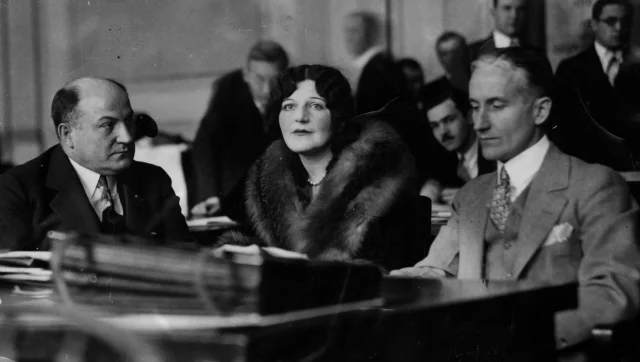George Remus: America’s Greatest Bootlegger and the Great Gatsby
Ανδρέας Μπότσαρης•Articles
More than ninety years have passed since the repeal of Prohibition in 1933, an era that forever changed American society and its economy. During these years, the stories of those who amassed fortunes through illegal alcohol trafficking continue to captivate and inspire. Among these tales, the life of George Remus, known as the “King of the Bootleggers,” stands out. His life, filled with wealth, scandal, and dramatic twists, seems like a tale ripped from a novel. In fact, many believe he was the inspiration for F. Scott Fitzgerald‘s Jay Gatsby.
From Germany to the American Dream
Born in 1877 in Landsberg, Germany, George Remus emigrated to the United States with his family in 1883. After brief stays in Maryland and Wisconsin, they settled in Chicago, seeking opportunities for a better life. His difficult childhood, under the tyranny of an alcoholic father, led him to leave school at the age of 13 to work at his uncle’s pharmacy. However, driven by ambition, he managed to study pharmacy and later law. By 1900, he had his own law firm in the Ashland Block Building. His reputation as a lawyer grew thanks to his innovative defenses, such as introducing temporary insanity as a legal argument.

Cincinatti Enquirer
The Rise of George Remus as King of Prohibition
Prohibition in 1920 proved to be the opportunity Remus had been waiting for. Using his knowledge of pharmacy and law, he identified a legal loophole: alcohol could be prescribed as a “medicinal product.” Before Prohibition, distillers storing whiskey in government warehouses received certificates that could be redeemed to retrieve barrels upon paying taxes. Remus began purchasing these certificates in bulk, realizing he could bottle and sell whiskey as “medicinal alcohol,” exploiting the fact that the law banned the purchase of whiskey but not the purchase of certificates for barrels intended for medicinal use.
Remus’s Plan, Known as “The Circle,” Was Built on Four Key Steps:
- Buying Closed Distilleries
Remus purchased closed distilleries to gain control of the whiskey stored in their warehouses. - Acquiring Pharmaceutical Companies
He invested in pharmaceutical companies to control the distribution of “medicinal whiskey,” which could legally be sold with a prescription. - Securing Government Licenses
Through these licenses, he could legally remove whiskey from warehouses and sell it to his own pharmaceutical companies for lawful distribution. - Creating a Transportation Network and Staging “Thefts”
He established a transportation company with a fleet of trucks for whiskey delivery. He then organized a team to “steal” his own trucks, hiding the barrels and selling them on the black market for a much higher profit.
Through this multi-layered scheme, Remus controlled over 35% of the country’s whiskey reserves, becoming the undisputed ruler of the illegal whiskey market. He acquired a total of 14 distilleries, including the Squibb Distillery in Lawrenceburg, Indiana, the Rugby Distillery in Louisville, and the Burks Spring Distillery in Loretto, now known as Maker’s Mark. He also held stakes in famous distilleries like Jack Daniel’s, Pogue Distillery in Maysville, Edgewood Distillery in Cincinnati, and Hill and Hill in Owensboro. His earnings were estimated at $25 million annually, equivalent to $400 million today.

Photo by Andreas Botsaris for Bitterbooze.com – © All Rights Reserved
The glitz and the fall of George Remus
George Remus was known for his extravagant lifestyle. He bought a mansion in Price Hill, Cincinnati, equipped with an Olympic-sized indoor pool and secret underground tunnels. He threw legendary parties, gifting guests with presents worth thousands of dollars. At one such party, every woman received a Pontiac car.
However, his notoriety as a bootlegger and lawbreaker eventually drew the attention of authorities. In 1925, he was arrested and sentenced to two years in prison for violating the Volstead Act, which enforced Prohibition.
The Department of Justice assigned agent Franklin Dodge to investigate rumors of corruption at the Atlanta prison where Remus was serving his sentence. Ironically, it was Remus who suggested his wife, Imogene, contact Dodge, hoping to bribe him for early release. But events took a dramatic turn: Imogene fell for Dodge, and the two began an affair. Exploiting the power of attorney Remus had granted her, Imogene and Dodge liquidated his assets, selling off distilleries and his valuable collection of historical artifacts, destroying his empire while he was behind bars.

Cincinnati Enquirer
When Remus was released from prison in 1927, he discovered he had lost almost everything. During their divorce proceedings, his rage boiled over. On the day the divorce was to be finalized, he tracked Imogene to her hotel. Seeing her get into a taxi with her stepdaughter Ruth, he followed them in a high-speed chase through the streets of Cincinnati. Remus forced the taxi to stop at Eden Park. Imogene got out and ran up a hill. Enraged, Remus chased her, grabbed her wrist, pulled out a gun, and fatally shot her in front of her daughter.
Remus decided to represent himself at his trial for Imogene’s murder, pleading temporary insanity. Using the trial as a platform, he denounced Prohibition as the root of his troubles and societal corruption. His passionate defense won over the jury, who acquitted him after only 19 minutes of deliberation. After the trial, he spent six months in a psychiatric institution before being deemed mentally fit and released.
George Remus lived the rest of his life in relative peace in northern Kentucky, away from the public eye. He passed away in 1952, leaving behind a story so remarkable that it continues to fascinate to this day.
Connection to The Great Gatsby
Remus’s lavish lifestyle and opulent parties are often linked to the character of Jay Gatsby. F. Scott Fitzgerald is believed to have drawn inspiration from Remus, whom he likely encountered during a stay at the Seelbach Hotel in Louisville. The similarities are striking: a man who amasses immense wealth through illegal activities, hosts extravagant parties, and is ultimately undone by a woman.

Photo by Andreas Botsaris for Bitterbooze.com – © All Rights Reserved
George Remus Whiskey
Today, the name George Remus lives on not just through his incredible story but also through the whiskey bearing his name. The Ross & Squibb Distillery and MGP in Lawrenceburg, Indiana, honor the “King of the Bootleggers” with a series of Prohibition-style bourbons.








